The lives come first Why Western cultural institutions need to support Afghan artists
“I am heartbroken today and there is not a shred of hope left in my life.â€
So begins a Thursday social media post by an Afghan photographer in Kabul. The accompanying image shows an armed Taliban fighter walking past a billboard bearing the faces of women that have been hastily obscured with blobs of black spray paint.
“Today is World Photography Day,†she continues, “and as an Afghan woman, I am not allowed to use my camera. With the arrival of Taliban in Afghanistan, everything changed.â€
For the sake of her safety â€" her post was a private one â€" I will leave her unnamed.
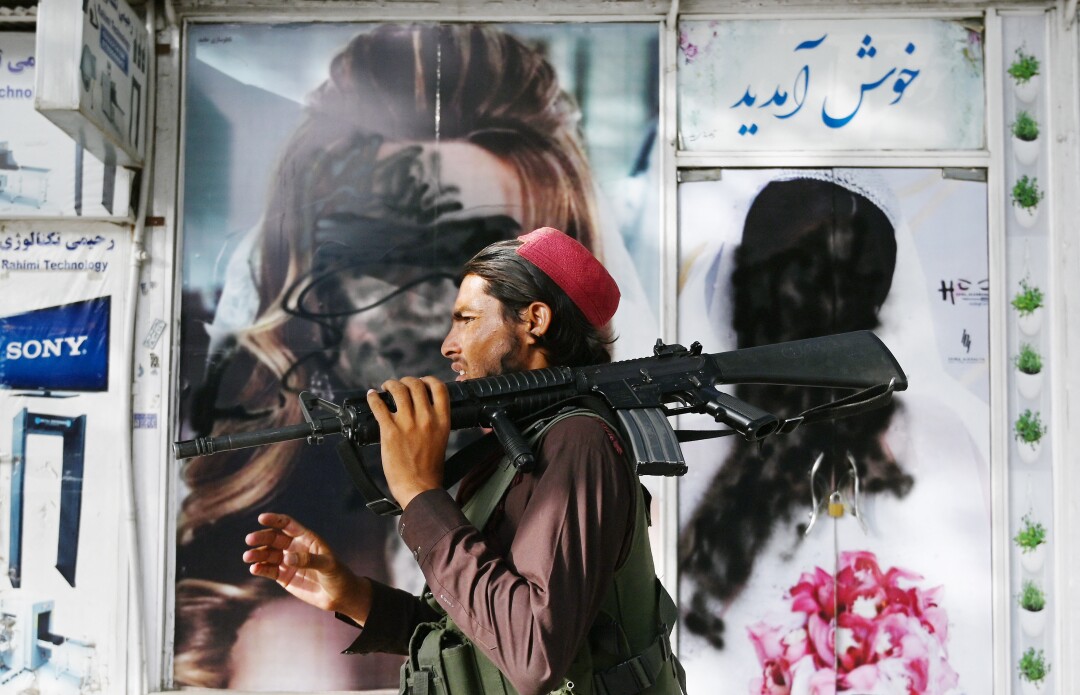 A Taliban fighter on Wednesday walks past a beauty salon showing images of women that have been obscured in Kabul.(Wakil Kohsar / AFP via Getty Images)
A Taliban fighter on Wednesday walks past a beauty salon showing images of women that have been obscured in Kabul.(Wakil Kohsar / AFP via Getty Images) The last week in Afghanistan has been vertiginous. The withdrawal of the United States military from the country has led to the lightning-fast collapse of the U.S.-funded government of Ashraf Ghani and the triumphant march of the Taliban into Kabul â€" complete with scenes of armed fighters occupying the presidential palace.
This has left thousands of Afghans who worked for the U.S. stranded and vulnerable to Taliban retribution. Already, there are reports of the Taliban going door to door in search of interpreters and other workers who collaborated with Western governments or media organizations.
Also vulnerable: artists, musicians, filmmakers, academics and other cultural workers, who now find themselves the targets of Taliban orthodoxies that typically proscribe music, the representation of the human figure and the free movement of women.
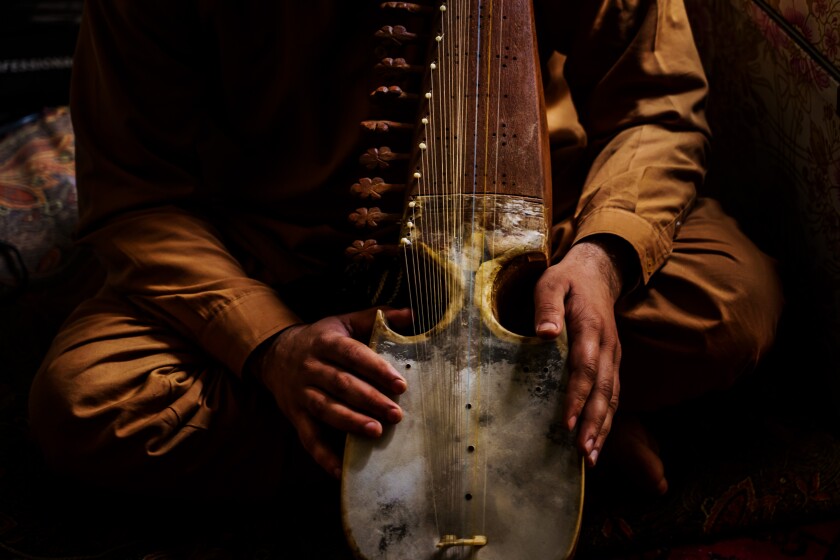
World & Nation
Musicians faced death under Taliban rule. They may be silenced once more
An Afghan tradition was all but stamped out by religious extremists who â€" hearing sin instead of song â€" outlawed music and threatened with death its practitioners.
Mohsin Taasha, an Afghan painter who has shown his work internationally â€" including documenta, the quinquennial based out of Kassel, Germany â€" was able to leave Afghanistan a few days prior to the fall of the Ghani government and is now in France. But he says the situation remains critical for those left behind.
“The artists in Afghanistan today risk their lives, because [of] their [beliefs], because of their thoughts, and because of their existence as free men and women,†he tells me via Whatsapp.
Filmmaker Shahrbanoo Sadat, who won the top Directors’ Fortnight award at Cannes in 2016 for “Wolf and Sheep,†and who was in Kabul when the Taliban marched into the city, told the Hollywood Reporter‘s Alex Ritman that the situation on the ground is grim. Getting approved for evacuation is an ordeal; so is making it to the airport, which is ringed by Taliban checkpoints and has been a scene of chaos and violence. “If I survive this and I have the chance to make more films,†she told Ritman, “my cinema will have changed forever.â€
Sahraa Karimi, who in 2019 became the first woman to lead the national cinema organization, Afghan Film, issued a plea for assistance to the international film community on Twitter: “Everything that I have worked so hard to build as a filmmaker in my country is at risk of falling. If the Taliban take over they will ban all art. I and other filmmakers could be next on their hit list.â€
To All the #Film_Communities in The World and Who Loves Film and Cinema!
I write to you with a broken heart and a deep hope that you can join me in protecting my beautiful people, especially filmmakers from the Taliban. #Share it please, don't be #silent. pic.twitter.com/4FjW6deKUi
â€" Sahraa Karimi/ صØرا كريمي (@sahraakarimi) August 13, 2021“The most important thing [Western] cultural institutions can do for the artists who fear for their lives in Afghanistan due to threats by Taliban,†Taasha tells me, “is to help them relocate in safe places.â€
The threats of violence are such that most of the Afghan artists and cultural workers I contacted while reporting this story â€" both in and out of the country â€" declined to be interviewed on the grounds that it could endanger their own lives, or those of their families and friends. One cultural worker, who is now out of the country, says he’s already heard of at least one instance in which an artist’s family home has been searched by the Taliban.
“The people under threat,†he says, “are the normal citizens.â€
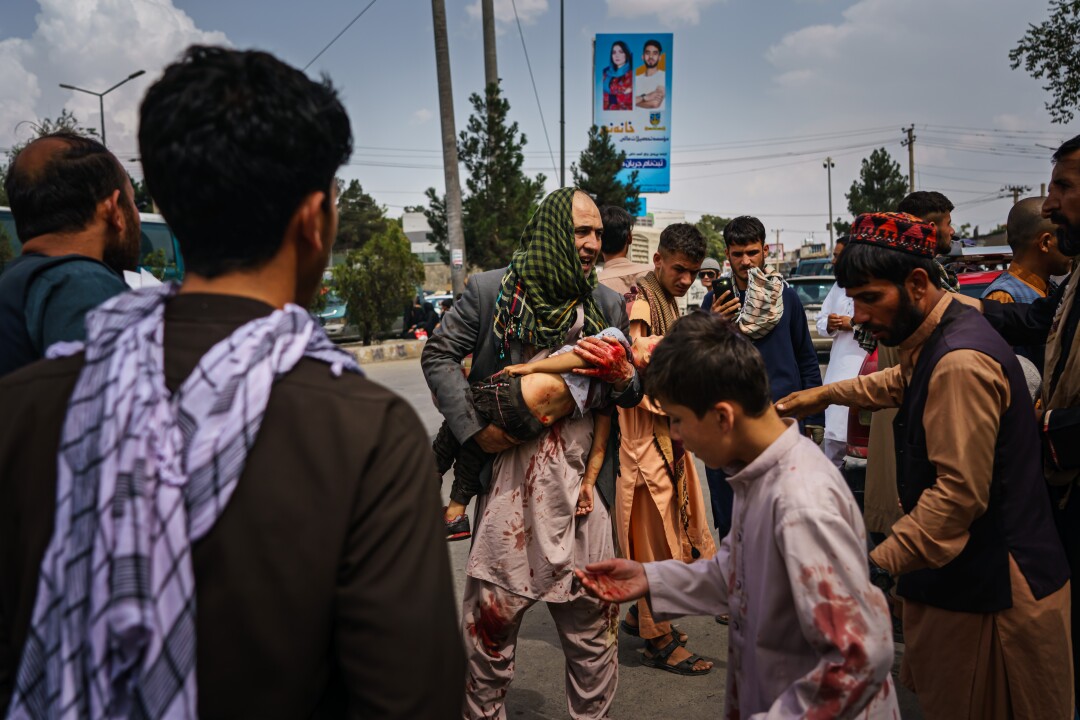 Taliban fighters used gunfire and other weapons on a crowd of thousands of people who had assembled around Kabul’s airport. A woman and a boy, shown above, were among those injured in the confrontation.(Marcus Yam / Los Angeles Times) ‘A question of days’
Taliban fighters used gunfire and other weapons on a crowd of thousands of people who had assembled around Kabul’s airport. A woman and a boy, shown above, were among those injured in the confrontation.(Marcus Yam / Los Angeles Times) ‘A question of days’ “Cultural institutions need to lobby their government,†says Ixone Sádaba. “It’s a professional and personal duty.â€
Sádaba, an artist from Spain, is the founder, along with human rights lawyer Ignacio RodrÃguez Tucho, of a four-year-old organization called Moving Artists, based in Bilbao. It works to connect Western artists and institutions with artists living in conflict zones such as Afghanistan and Iraq. In the past, this has meant helping Iraqi artists secure the necessary paperwork and visas to participate in residencies abroad, or facilitating workshops and residencies by European artists in cities such as Kabul and Sulaymainyah, in Iraqi Kurdistan.
The organization is lobbying the Spanish government to include Afghan artists, filmmakers and academics on evacuation lists â€" and to maintain some semblance of security around Kabul’s airport so those who are approved are able to leave the country. The window in which to accomplish this, she says, is growing ever smaller. “It’s now a question of days.â€
All of this makes it a critical moment for Western cultural institutions to lobby their political leaders. “People need to pick up the phone.â€
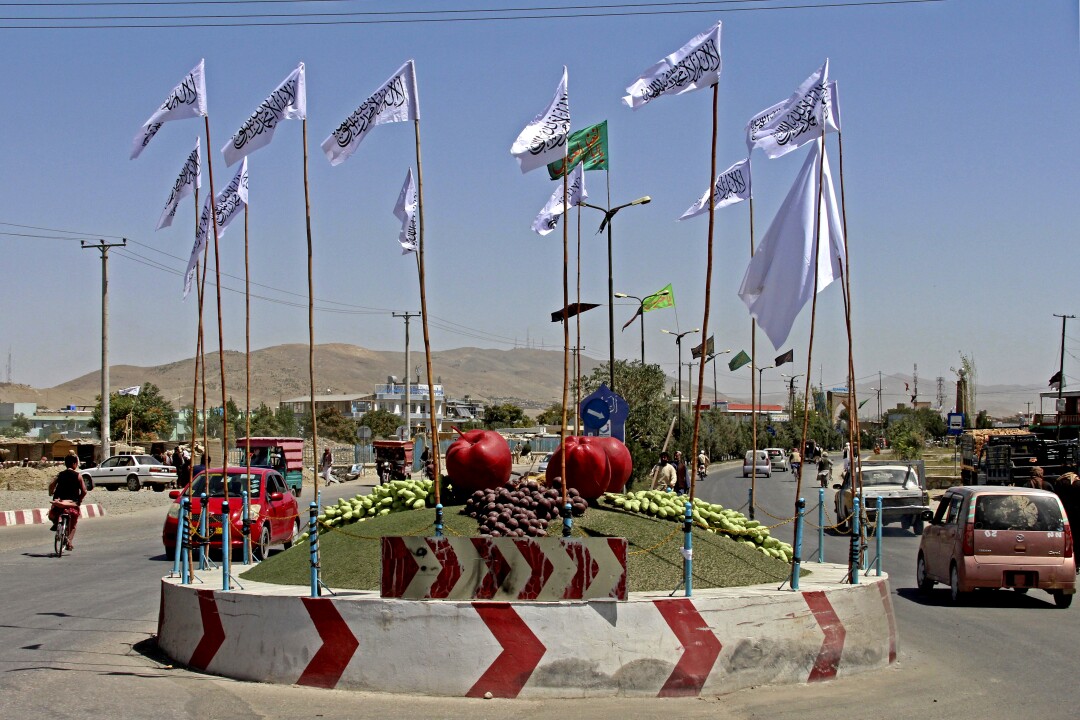 Taliban flags fly in a traffic circle in the city of Ghazni, southwest of Kabul.(Gulabuddin Amiri / Associated Press)
Taliban flags fly in a traffic circle in the city of Ghazni, southwest of Kabul.(Gulabuddin Amiri / Associated Press) In the United States, the Afghan American Artists and Writers Assn. has called for the processing of P2 visas (performing arts visas) to be expedited and the definition broadened to include other vulnerable groups, such as women and members of the LGBTQ community.
Gazelle Samizay is an Afghan-born, San Francisco-based artist who is helping run a crowdfunding effort on behalf of the association to support more than half a dozen artists who need assistance to get out of the country. She says it is critical for Western cultural institutions to maintain pressure on their respective governments to cut the red tape for artists. Many artists, she notes, have made work that directly criticizes the Taliban. “This further puts them in danger.â€
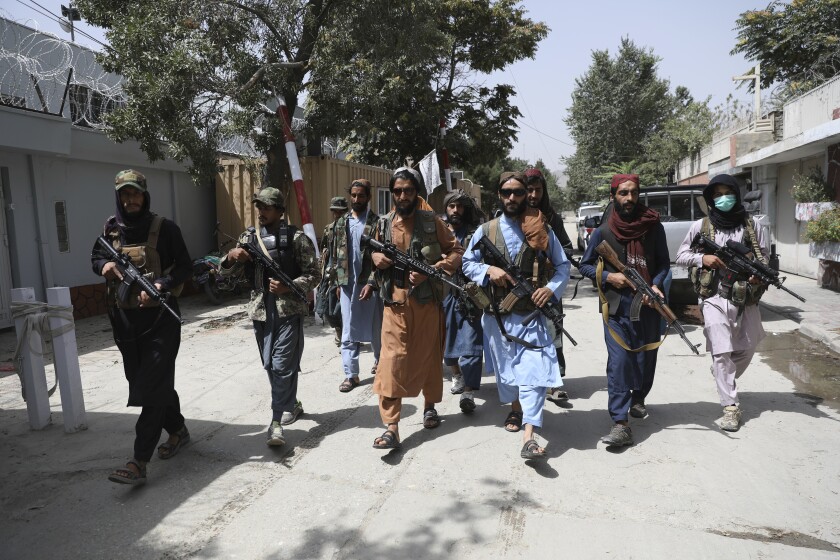
Opinion
Granderson: The Taliban’s return means death for LGBTQ Afghans. Biden, will you help?
‘They are going to do what the Nazis did to LGBT people. They are going to try to exterminate us,’ says one Afghan activist.
Independent curator Muheb Esmat, an Afghan national who lives in New York, says that if there were ever a moment for U.S. cultural centers to offer residencies or guest artist spots to Afghans, that time is now. “Universities, they can give artists visas and residencies,†he says. “These institutions can provide them with ways to get out.â€
“The lives comes first.â€
What’s at stakeIn 1996, when the Taliban took over Kabul the first time, the artist Yousef Asefi managed to talk his way into the country’s National Gallery, where, armed with nothing but a paintbrush and some watercolors, he got to work painting over dozens of human figures in the collection’s paintings. The Taliban had implemented an edict against the representation of the human figure in any form. By covering them up, Asefi was hopeful that the paintings would evade destruction.
Fast forward half a dozen years, to the spring of 2002, about six months after the U.S. invasion had installed Hamid Karzai as Afghanistan’s interim president, when Asefi â€" at a ceremony held to mark the reopening of the National Gallery â€" delighted the assembled crowd, including Karzai, by washing the watercolor off of an oil painting, revealing the human figures underneath.
“This is more, so much more, than the reopening of a museum,†Karzai said in his remarks at the time.
It was a rare moment of continuity for Afghan culture amid a tumultuous decades-long period that had seen a Soviet invasion and withdrawal, as well as coups, an insurgency and iconoclasm in between.
A museum may be an important repository of valuable objects, but it’s a nation’s artists who function as its most valuable keepers of memory â€" both official and unofficial.
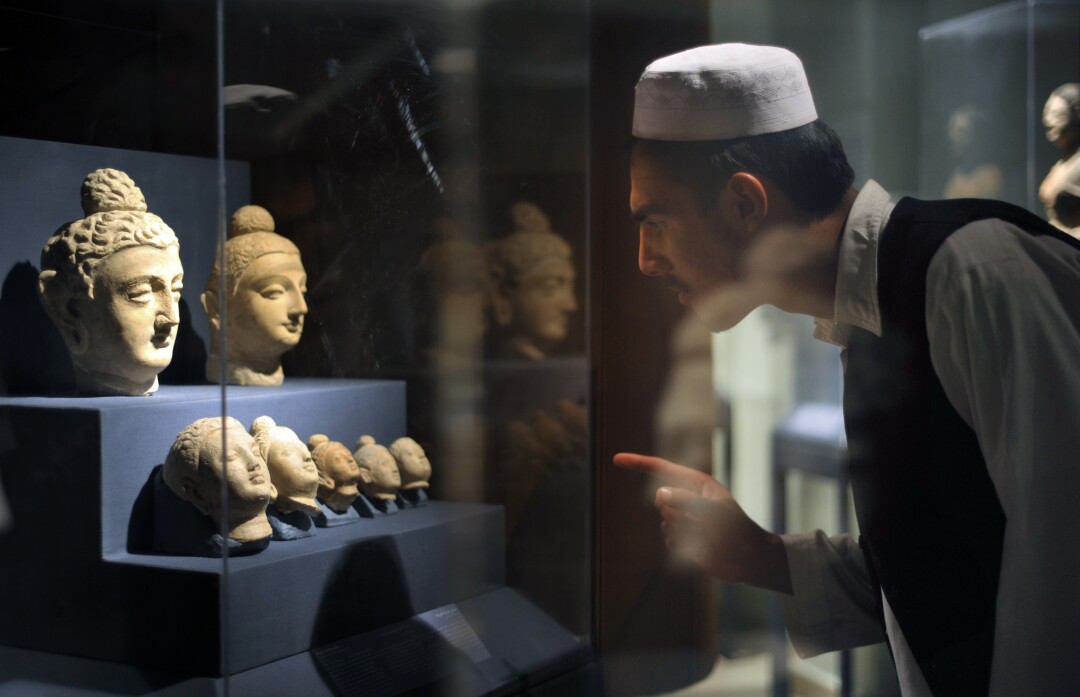 An Afghan student looks at a display of Buddha heads at the National Museum of Afghanistan in Kabul in 2012 â€" the sort of cultural happening that would have been forbidden under the first Taliban regime.(Bay Ismoyo / AFP via Getty Images)
An Afghan student looks at a display of Buddha heads at the National Museum of Afghanistan in Kabul in 2012 â€" the sort of cultural happening that would have been forbidden under the first Taliban regime.(Bay Ismoyo / AFP via Getty Images) Over the last 20 years of U.S. intervention, those memory keepers have included a generation of contemporary artists and filmmakers that have emerged both in Afghanistan and in an Afghan diaspora atomized between Europe, Australia and the United States. It’s an important, if fragile, cultural network that has helped preserve ideas in a country where the Taliban has done its best to obliterate them.
“Those voices,†says Sádaba, “we have to preserve them.†To abandon them now would be to abandon the good that has come out of the last two decades.
After the fall of the Taliban, art in Kabul began to blossom. A group of cultural workers, led by artist and writer Rahraw Omarzad, established the Center for Contemporary Arts Afghanistan, an art school in Kabul intended to engage fresh ways of thinking.
The city also played host to a variety of happenings. The Afghan branch of the Institut Français arranged exhibitions by local artists organized by curator Guilda Chahverdi (who, in 2019, curated a group show of contemporary Afghan art at Mucem in Marseille). In 2012, the city was a featured location for documenta 13 â€" an exhibition that drew 27,000 people.

Television
American TV ignored Afghanistan. Until parachuting in to watch it fall
TV news covers foreign affairs most closely when the U.S. invades a country or retreats from it. The message is clear: Spectacle beats substance.
During this time, there was also activity abroad. In 2005, artist Lida Abdul, who was born in Afghanistan but has been living in Los Angeles for more than a decade, represented Afghanistan at the 51st Venice Biennale â€" the first and only time the country has had a pavilion at the exhibition. Featured was Abdul’s video piece “White House,†which shows the artist painting the ruins of the former presidential palace in Kabul a bright shade of white â€" a comment on U.S. intervention but also Afghan attempts at renewal.
“Her work goes beyond nationalistic boundaries,†says Sara Raza, founder of a New York-based curatorial studio called Punk Orientalism. She has worked with Abdul since 2003 and contributed an essay for the Venice Biennale’s catalog. “It’s about cinema. It’s about architecture. It’s not just Afghanistan. It could be any country that undergoes a traumatic period. Kabul could be be comparable to Beirut or parts of the former Yugoslavia.â€
Abdul is despairing about the situation now facing many artists in the country: “All doors appear to have shut for young artists, especially for female artists,†she states via email. “But I remain hopeful that art will stay alive in Afghanistan despite the challenges.â€
Time to step upIf the disintegration of the Afghan government came as a surprise to the nattering nabobs on TV, it certainly came as no surprise to the country’s artists, who have been contending with escalating violence for years. In 2014, a theater performance about terrorism at the Institut Français was attacked by a suicide bomber, killing several people.
The Center for Contemporary Arts Afghanistan hasn’t updated its Facebook page since February and its website no longer functions. Attempts to reach Asefi via social media were unsuccessful. Already, those who have been able have relocated to other countries.
Esmat, who last visited Afghanistan in 2019, says the growing number of threats had long been “behind every cultural worker’s mind.†The government, weak as it was, could offer little in the way of support. “Artists were left to their own devices,†he says.
Now they face persecution.
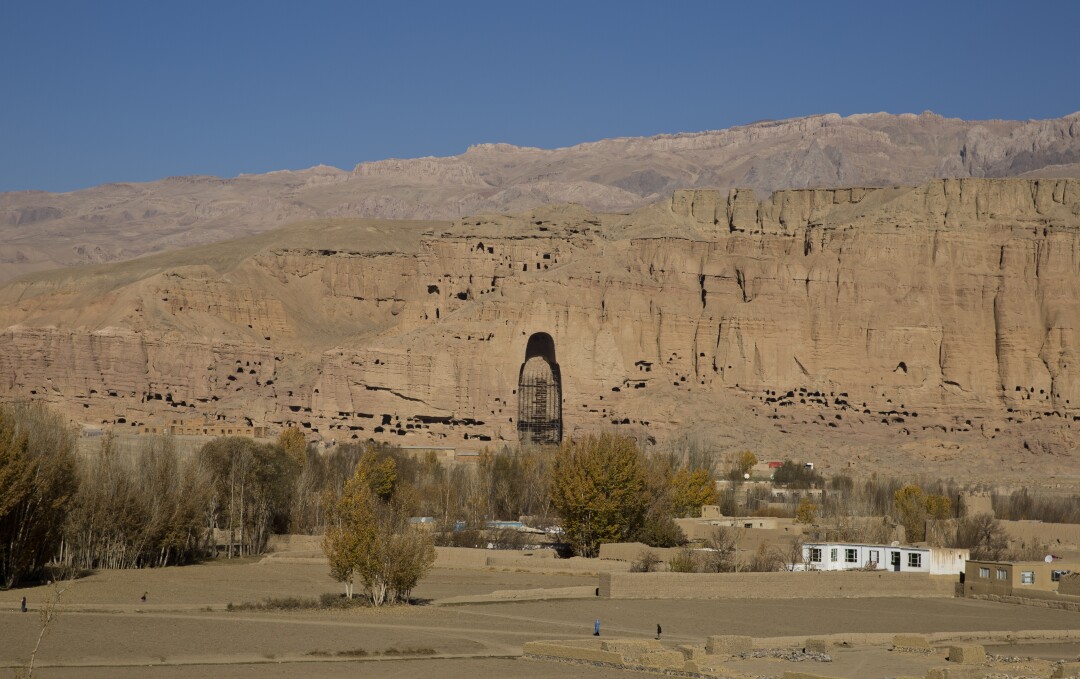 In 2001, the Taliban dynamited the great Buddhas at Bamian, monumental works built between the 3rd and 5th centuries. The area, seen here in 2016, represented a fusion between Buddhist and ancient Greek art.(Massoud Hossaini / Associated Press)
In 2001, the Taliban dynamited the great Buddhas at Bamian, monumental works built between the 3rd and 5th centuries. The area, seen here in 2016, represented a fusion between Buddhist and ancient Greek art.(Massoud Hossaini / Associated Press) As the Taliban takes over, Afghanistan’s cultural legacy â€" its museums, its artifacts and its monuments â€" once again is in the crosshairs. In the late 1990s and early 2000s, the Taliban famously destroyed thousands of artifacts, as well as the towering Buddhas at Bamian, structures built in the pre-Islamic era, between the 3rd and 5th centuries.
Now, objects that survived the first Taliban rule may not survive a second. An anonymous Afghan museum curator interviewed by Martin Bailey of the Art Newspaper was pessimistic about the future of the country’s heritage. “Do leopards change their spots?†he says of the Taliban. “One only has to look at the command structure of the Taliban and their supporters to feel that there won’t be much of a change from 2001 â€" and it might well be worse.â€
Also at risk are more ephemeral traditions, known as intangible cultural heritage, which includes practices such as storytelling, dance, poetry and music â€" traditions often handed down from one person to the next.
In July, my colleagues Nabih Bulos and Marcus Yam produced an extensive report on the grim future faced by the musicians who play and fabricate the rubab, an ancient Afghan instrument akin to the lute. “Afghans call it ‘the lion of instruments,’†writes Bulos. “Its picking and strumming can mirror the ebbs and flows of ghazal song poems, or if it’s heard solo, its strings resonate across the spectrum of a virtuoso’s improvisations.â€
That intangible cultural heritage is about to be silenced, its memory erased.
 A man holds an Afghan rubab in his workshop in May. The instrument is a mainstay of Afghan classical music. (Marcus Yam / Los Angeles Times)
A man holds an Afghan rubab in his workshop in May. The instrument is a mainstay of Afghan classical music. (Marcus Yam / Los Angeles Times) In a self-portrait posted to Instagram on Saturday afternoon, filmmaker and photographer Roya Heydari is seen sitting alongside the Kabul airport tarmac. “I left my whole life, my home in order to continue to have a voice,†she writes. “Once again, I am running from my motherland. Once again, I am going to start from zero. I took only my cameras and a dead soul with me across an ocean.â€
It’s time for Western cultural leaders to speak up. Human lives â€" and legacies of a centuries-old culture â€" are at stake.

0 Response to "The lives come first Why Western cultural institutions need to support Afghan artists"
Post a Comment